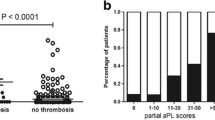Abstract
A significantly high correlation between reduced activity of Annexin A5 by the flow cytometric assay (FCA) and the diagnosis of antiphospholipid syndrome (APS) has been reported. The aim of this study was to assess the clinical and laboratory significance of the Annexin A5 competition assay among patients with systemic lupus erythematosus (SLE). The FCA competition assay was performed on blood samples from 57 consecutive SLE patients. The FCA was performed according to a previously validated method. Forty-seven patients (82.5 %) had SLE without APS and ten (17.5 %) had SLE with APS. Twenty-four (42 %) of the patients had mean levels of AnxA5 fluorescence below the mean and standard deviation of the controls and were considered positive. SLE patients with a positive FCA were found to have an increased risk for a hypercoagulable or vascular state (86 % of the patients had cerebrovascular disease, 89 % had Raynaud’s phenomenon, and 80 % had deep vein thrombosis). The risk for any hypercoagulable or vascular state was significantly increased (P = 0.012, RR−2.3, 95 % CI 1.4–3.8). A positive FCA assay was found in 90 % of the patients with APS (P < 0.001), with a sensitivity of 90 % and a specificity of 68 % for this diagnosis. The positive and negative predictive values were 0.4 and 0.97, respectively. Correlations were found between positive FCA and positive Anti-Cardiolipin antibody (P < 0.001), and Anti-β2 glycoprotein I levels (P = 0.013). Our findings suggest that the FCA is a practical assay for the detection of clinically relevant APS among patients with SLE.


Similar content being viewed by others
References
Sherer Y, Gorstein A, Fritzler MJ, Shoenfeld Y (2004) Autoantibody explosion in systemic lupus erythematosus: more than 100 different antibodies found in SLE patients. Semin Arthritis Rheum 34:501–537
Ruiz-Irastorza G, Crowther M, Branch W, Khamashta MA (2010) Antiphospholipid syndrome. Lancet 376:1498–1509
Giannakopoulos B, Krilis SA (2013) The pathogenesis of the antiphospholipid syndrome. N Engl J Med 368:1033–1044
Rand JH, Wu XX, Quinn AS, Taatjes DJ (2010) The annexin A5-mediated pathogenic mechanism in the antiphospholipid syndrome: role in pregnancy losses and thrombosis. Lupus. 19:460–469
Reutelingsperger CP (2001) Key regulators of haemostasis, thrombosis, and apoptosis. Thromb Haemost 86:413–419
Rand JH, XX W, Lapinski R et al (2004) Detection of antibody-mediated reduction of annexin A5 anticoagulant activity in plasmas of patients with the antiphospholipid syndrome. Blood 104:2783–2790
De Laat B, XX W, van Lummel M, Derksen RH, de Groot PG, Rand JH (2007) Correlation between antiphospholipid antibodies that recognize domain I of beta2-glycoprotein I and a reduction in the anticoagulant activity of annexin A5. Blood 109:1490–1494
Cederholm A, Frostegård J (2007) Annexin A5 as a novel player in prevention of atherothrombosis in SLE and in the general population. N Y Acad Sci 1108:96–103
Rand JH, XX W, Quinn AS, Taatjes DJ (2008) Resistance to annexin A5 anticoagulant activity: a thrombogenic mechanism for the antiphospholipid syndrome. Lupus 17:922–930
Hrycek A, Cieślik P (2012) Annexin A5 and anti-annexin antibodies in patients with systemic lupus erythematosus. Rheumatol Int 32:1335–1342
Thiagarajan P, Tait JF (1990) Binding of annexin V/placental anticoagulant protein I to platelets. Evidence for phosphatidylserine exposure in the procoagulant response of activated platelets. J Biol Chem. 265:17420–17423
Tomer A (2002) Antiphospholipid antibody syndrome: rapid, sensitive, and specific flow cytometric assay for determination of anti-platelet phospholipid autoantibodies. J Lab Clin Med 139:147–154
Hunt BJ, Wu X-X, de Laat B, Arslan AA, Stuart-Smith S, Rand JH (2011) Anticoagulant activity in women with histories for obstetric antiphospholipid syndrome. Am J Obstet Gynecol 205:485.e17–485.e23
Tomer A, Bar-Lev S, Fleisher S, Shenkman B, Friger M, Abu-Shakra M (2007) Antiphospholipid antibody syndrome: the flow cytometric annexin A5 competition assay as a diagnostic tool. Br J Haematol 139:113–112
Hochberg MC (1997) Updating the American College of Rheumatology revised criteria for the classification of systemic lupus erythematosus. Arthritis Rheum 40:1725
Bombardier C, Gladman DD, Urowitz MB, Caron D, Chang CH (1992) (1992) derivation of the SLEDAI. A disease activity index for lupus patients. The committee on prognosis studies in SLE. Arthritis Rheum. 35:630–640
Gladman DD, Ginzler E, Goldsmith C et al (1996) The systemic lupus international collaborating clinics/ACR damage index for SLE. Arthritis Rheum 39:363–369
Miyakis S, Lockshin MD, Atsumi T et al (2006) International consensus statement on an update of the classification criteria for definite antiphospholipid syndrome (APS. J Thromb Haemost 4:295–306
Cederholm A, Frostegård J (2005) Annexin A5 in cardiovascular disease and systemic lupus erythematosus. Immunobiology 210:761–768
Author information
Authors and Affiliations
Corresponding author
Ethics declarations
Disclosures
None.
Rights and permissions
About this article
Cite this article
Avriel, A., Fleischer, S., Friger, M. et al. Prediction of Antiphospholipid syndrome using Annexin A5 competition assay in patients with SLE. Clin Rheumatol 35, 2933–2938 (2016). https://doi.org/10.1007/s10067-016-3428-1
Received:
Revised:
Accepted:
Published:
Issue Date:
DOI: https://doi.org/10.1007/s10067-016-3428-1




